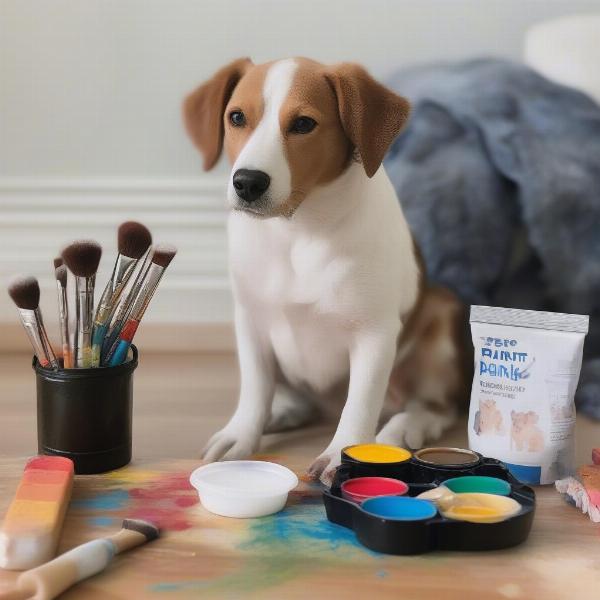Dog paint face is a growing trend, especially around holidays and special occasions. But is it safe? And if so, what’s the right way to do it? This article will explore the dos and don’ts of painting your dog’s face, ensuring a fun and safe experience for both you and your furry friend.
Choosing Safe Paints for Your Dog’s Face
The most important aspect of dog face painting is using non-toxic, pet-safe paints. Never use acrylic, oil, or tempera paints, as these can be harmful if ingested or absorbed through the skin. Look for paints specifically designed for pets, or opt for natural, DIY options like food coloring mixed with cornstarch and water. Always test a small amount of paint on a less sensitive area of your dog’s skin before applying it to their face. If there’s any redness or irritation, discontinue use immediately.
 Dog Face Painting Supplies
Dog Face Painting Supplies
Step-by-Step Guide to Painting Your Dog’s Face
Once you have the right paint, follow these steps:
- Prepare your workspace: Cover your work area with newspaper or a drop cloth. Have some treats on hand to keep your dog calm and occupied.
- Introduce the paint gradually: Let your dog sniff the paint and brushes, rewarding them with treats and praise.
- Start with simple designs: Begin with small, simple designs, like a heart or a star. Avoid painting near the eyes, nose, and mouth.
- Use gentle strokes: Apply the paint in thin, gentle strokes. Avoid pressing too hard, which could irritate your dog’s skin.
- Take breaks: If your dog becomes restless or uncomfortable, take a break and try again later.
- Remove the paint: Once the paint is dry, gently wipe it off with a damp cloth or pet-safe wipes.
Alternatives to Traditional Face Paint
If you’re unsure about using paint on your dog’s face, consider alternatives like pet-safe chalk or stencils. These options are easy to apply and remove, and they offer a fun way to dress up your dog without the use of paint. You could also consider purchasing face paint for dogs for more intricate designs.
Is Face Painting Stressful for Dogs?
Not all dogs enjoy having their faces painted. Pay close attention to your dog’s body language. If they show signs of stress, like panting, whining, or trying to move away, stop the activity. Some dogs might tolerate dog face paint better than others.
Conclusion
Dog face painting can be a fun and creative way to celebrate special occasions with your furry friend. However, always prioritize your dog’s safety and comfort. Choose non-toxic paints, follow the proper application techniques, and be mindful of your dog’s reactions. Remember, a happy and healthy dog is always more important than a perfectly painted face. Check out our articles on dog by pablo picasso and custom pajamas with dog face for more fun ideas.
FAQ
- What type of paint is safe for dogs? Only use non-toxic, pet-safe paints or natural DIY options.
- Can I use human face paint on my dog? No, human face paint can contain harmful chemicals.
- What should I do if my dog shows signs of discomfort during face painting? Stop immediately and remove the paint.
- How do I remove the paint from my dog’s face? Use a damp cloth or pet-safe wipes.
- Are there alternatives to face painting? Yes, consider pet-safe chalk, stencils, or bandanas.
Looking for more ways to celebrate your dog’s birthday?
Check out our article on birthday cards for dogs.
About ILM Dog
ILM Dog is your trusted resource for all things dog-related. We offer expert advice on dog breeds, health and medical care, training and behavior, nutrition, grooming, exercise, puppy care, senior dog care, and traveling with your dog. We also provide detailed information on various dog products and accessories. Our expert team at ILM Dog is dedicated to providing you with the best possible information to ensure your dog lives a long, happy, and healthy life. For all inquiries, please contact us via email at [email protected] or by phone at +44 20-3965-8624.